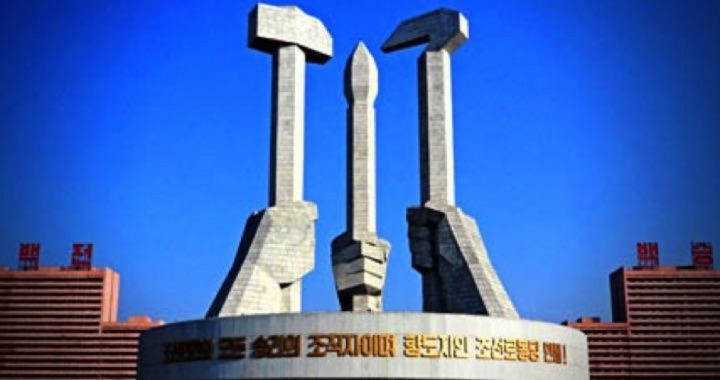
President Trump, speaking from his golf resort in Bedminster, New Jersey, on August 8, said: “North Korea best not make any more threats to the United States. They will be met with fire and fury like the world has never seen.”
Trump explained the reason for his strong language by stating that North Korean Leader Kim Jong-un has been “very threatening beyond a normal statement.” The president presumably was referring to statements the North Korean made after the UN Security Council recently levied sanctions against his regime in response to North Korea’s continued testing of nuclear weapons and ballistic missiles.
Following Trump’s statement, a spokesman for the Korean People’s Army (KPA) told KCNA (the Korean Central News Agency) that it would carry out a pre-emptive operation if there were signs of U.S. provocation and threatened to fire a long-range missile against the U.S. base in Guam.
“The KPA Strategic Force is now carefully examining the operational plan for making an enveloping fire at the areas around Guam with medium-to-long-range strategic ballistic rocket Hwasong-12 in order to contain the U.S. major military bases on Guam including the Anderson Air Force Base,” the spokesman said.
Britain’s Mirror — a tabloid known for its attention-grabbing, sensationalized headlines, made the most of the exchanges between Trump and Kim, running a story under the headline: “Live: US and North Korea on brink of war as Trump says America’s nuclear arsenal is ‘more powerful than ever.’ ”
As the volley of threats and counter-threats between Pyongyang and Washington continued, Secretary of State Rex Tillerson spoke during a stopover in Guam on August 9 and urged Americans to remain calm, saying he doesn’t believe there is “any imminent threat” from North Korea.
Tillerson emphasized that the United States did not believe that the threat from North Korea had changed. “Nothing that I have seen and nothing that I know of would indicate that the situation has dramatically changed in the last 24 hours,” he said, adding that “Americans should sleep well at night.”
The secretary also defended Trump’s strongly worded comments. “What the president is doing is sending a strong message to North Korea in language that Kim Jong Un can understand, because he doesn’t seem to understand diplomatic language,” Tillerson said. “I think the president just wanted to be clear to the North Korean regime on the U.S.’s unquestionable ability to defend itself, will defend itself and its allies.”
As we noted in an article earlier today, Guam’s Homeland Security Adviser George Charfauros reassured residents of the U.S. island territory that they were well protected against a missile attack from North Korea. That protection is provided by the Terminal High Altitude Area Defense (THAAD) missile system that is permanently stationed at Andersen Air Force Base on the island.
“There’s .00001 percent chance of that missile getting through that layer,” Charfauros told reporters at a news conference, according to Guam-based Pacific Daily News.
Charfauros provided details in a statement posted on the Guam Homeland Security/Office of Civil Defense Facebook page on August 9:
As of this morning, we have not changed our stance in confidence that the U.S. Department of Defense is monitoring this situation very closely and is maintaining a condition of readiness, daily. We will continue to keep the public updated on any changes or requests for action. For now, we advise the community to remain calm, remember that there are defenses in place for threats such as North Korea and to continue to remain prepared for all hazards.
Charfauros is in regular contact with the federal Department of Homeland Security and the Department of Defense, reported Good Morning America. He has not received any guidance that there is an imminent threat, reported Guam Homeland Security.
We have noted before that developing an effective anti-missile defense system against North Korean or other missile attacks makes sense. In the very preamble to our Constitution, our Founders noted that a key reason for establishing our government was to “provide for the common defense.” Who poses the biggest threat against us, however? Is it North Korea, or a more potent enemy?
Considering that North Korea is so technologically backward that it has difficulty in maintaining its electrical grid, can anyone believe that it poses any realistic military threat against the world’ greatest superpower?
The usual explanation is that North Korea is a “rogue” state whose leader’s bravado exceeds his common sense. But there are more likely explanations. One was provided by The New American’s foreign correspondent, Alex Newman, in an upcoming article:
Far from being “alone,” the communist regime in North Korea has had friends in high places from the beginning, and still does today. First and foremost, the regime is a puppet and close ally of the powerful communist dictatorship enslaving mainland China’s 1.3 billion people — a regime that is increasingly projecting its power globally.
A history of communist aggression toward the United States since the end of World War II showed us that the communist giants — China and the old Soviet Union — have never engaged us in war directly. They, instead, operate though puppets such as North Korea and North Vietnam (and even “Islamic” terrorists who are more red than Islamic), and bogged down U.S. forces in never-ending no-win wars that exhausted our resources mentally, morally, and economically.
The greatest threat posed by North Korea does not come from its missiles — which have been impressive during tests but are probably years away from practical operational use. A more likely development is that the conflict between Pyongyang and Washington will escalate into a second Korean War that will look much like the first Korean War. That is, a UN-directed operation against a Chinese supported enemy, where our military’s hands are tied by UN bureaucrats and victory is always elusive.
Image: Screenshot from the official site of the government of North Korea
Related articles:
Official Says North Korean Missile Has “.00001 Percent Chance” of Getting Through Defenses
North Korea Tests Ballistic Missile Capable of Reaching U.S. Base on Guam
In Test That Will Send Message to N. Korea, U.S. Successfully Intercepts ICBM
Successful Test of THAAD Anti-missile System Offers Hope for U.S. Defense
South Korea Says North Korean ICBM Lacks Re-entry Capability
Aircraft Carriers Gather Off N. Korea; Pyongyang Tests Missile Able to Hit Ships
Recently Tested North Korean ICBM Said to be in Range of Most of U.S.
N. Korea Continues Missile Tests; U.S. Moves 3rd Carrier Strike Force to Western Pacific
North Korea Tests Another Missile, Says They Are Ready to Deploy
North Korea Threatens U.S. With “All Out War” and “Weekly Missile Tests”
North Korea Threatens to Attack U.S. Carrier Group; Detains U.S. Citizen
North Korea Warns of Nuclear Retaliation at Any Sign of U.S. “Aggression”
North Korea Admits Missile Launches Were Test of Possible Strike Against U.S.Bases in Japan



